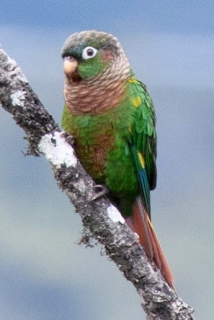Brown-breasted Conure |
|
|
Also known as: Brown-breasted Parakeet, Flame-winged Conure or Parakeet, Beautiful Conure
Photos
View in GalleryDid You Know?
Because Pyrrhura conures are adept at escaping aviaries it is essential that every corner and join in an enclosure for captive birds be inspected prior to placing the birds in.Academic Research
Related publications: Pyrrhura callipteraSpecies Profile
Genus: Pyrrhura | Species: calliptera
Size:
22cm (8.6 in)
Weight:
Probably 50-60g.
Subspecies including nominate:
one
Colour Adult:
Both adults green body; red/brown ear coverts; red/brown breast, faintly barred paler brown and dusky black; yellow primary coverts and carpal edge; red/brown tail. Bill horn coloured. Eye ring bare and white. Eye yellow.
Colour Juvenile:
As in adults but green primary coverts and carpal edge. Eye brown.
Call:
Calls in flight are harsh and are heard at long distances.
Video Links:
Video 1More Information:
Content Sources:
CITES
BirdLife International
Cornell Lab of Ornithology/Birds of the World
A Guide to Parrots of the World, Juniper and Parr, 1998
Parrots of the World, Forshaw, 2006. 2010 edition
Parrots in Aviculture, Low, 1992.
Parrots: Their Care and Breeding, Low, 1986.
Photos
View in GalleryDid You Know?
Because Pyrrhura conures are adept at escaping aviaries it is essential that every corner and join in an enclosure for captive birds be inspected prior to placing the birds in.Academic Research
Related publications: Pyrrhura callipteraSpecies Care
Captive Status:
Not usually found in captivity.
Longevity:
Not recorded.
Housing:
Enclosure 1 x 1 x 2m (3.3 x 3.3 x 6.5 ft) with shelter, minimum temperature 10C (50 F).
Diet:
Fruits such as: apple, pear, orange, banana, guava, mango, papaya, cactus fruits; vegetables such as: carrots, celery, green beans, peas in the pod; green leaves such as: Swiss chard, lettuce, kale, dandelion, sowthistle, chickweed; berries such as: mountain ash, elder and pyracantha; millet spray; soaked or sprouted sunflower; small seed mix such as: canary, millet, and smaller amounts of buckwheat, safflower, oats and a little hemp; cooked beans and pulses, boiled maize; complete kibble.
Enrichment:
Not recorded.
Nest Box Size:
Vertical box 25cm x 25cm x 70cm (10 x 10 x 30 in).
Clutch Size:
Not recorded.
Incubation Time:
Not recorded.
Fledging Age:
Not recorded.
Hatch Weight:
Not recorded.
Peak Weight:
Not recorded.
Weaning Weight:
Not recorded.
Photos
View in GalleryDid You Know?
Because Pyrrhura conures are adept at escaping aviaries it is essential that every corner and join in an enclosure for captive birds be inspected prior to placing the birds in.Academic Research
Related publications: Pyrrhura callipteraSpecies Wild Status
World Population:
5000-10,000, decreasing.
IUCN Red List Status:
Vulnerable
CITES Listing:
Appendix II
Threat Summary:
A BirdLife “restricted-range” species. Apparently extinct on the entire W slope of the E Andes. This species is declining due to habitat loss and persecution as a crop pest. No international trade recorded and only light local trade. Present in Chingaza National Park and adjacent protected areas.
Range:
C Colombia.
Habitat:
Found from 1500-3400m (4920-11,152 ft) in the upper subtropical and temperate zone cloud forest, other humid forest; also elfin woodland and paramo with bushes or scattered forest patches, and areas with shrubs, secondary growth, peatbog paramo and clearings.
Wild Diet:
Feeds on fruits of Cecropia, Clusia and Brunellia colombiana, blackberries Rubus and seeds of Espeletia uribeii and Cecropia. May take cultivated maize.
Ecology and Behaviour:
Gregarious; seen in groups of of 6-14 and sometimes more. Makes local altitudinal movements but otherwise is resident. Feeds mainly in trees and low bushes.
Clutch and Egg Size:
Not recorded.
Breeding Season:
August-October.
Related Links:
Photos
View in GalleryDid You Know?
Because Pyrrhura conures are adept at escaping aviaries it is essential that every corner and join in an enclosure for captive birds be inspected prior to placing the birds in.Academic Research
Related publications: Pyrrhura callipteraMembers Only Resources
Please log-in now to find more research, resources and tools.
Not a Member?
Find more great information:
Gain exclusive access to 600+ pages of additional research, seminars and podcasts, specialists to ask your toughest questions, and dozens of other fun resources - when you become a WPT member.
Join Today >>

































